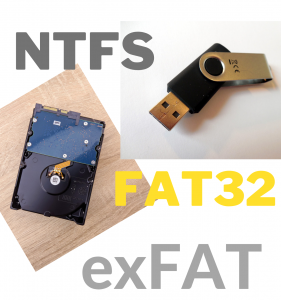When formatting a drive, Windows gives you three options: FAT32/exFAT/NTFS. What are they? They are file systems. A file system is a part of the operating system on a volume that determines how files are named, stored and organized on basic or dynamic disks. File systems are used by applications to store and retrieve files from storage devices. Files are placed in a hierarchical structure. The file system specifies the naming convention for the files, and the format for specifying the path to a file in the tree structure. The file system manages files and folders, as well as the information required by local and remote users, to locate and access these items.
There are mainly three kinds of file systems used by Windows- FAT32, exFAT and NTFS.
FAT32 (File Allocation Table, 32-bit cluster indices)
It’s a file system introduced in 1996 by Microsoft. It supports single file size of up to 4 GB and supports drives up to 2 TB in size. It offers wide compatibility. Most flash drives come formatted with FAT32 file system. It’s compatible with all versions of Windows, Mac, Linux, game consoles and most other devices with a USB port. It does not have permissions and other security features that are offered by NTFS. And modern versions of Windows cannot be installed to drives formatted with FAT32.
exFAT (extensible File Allocation Table)
It’s a file system introduced by Microsoft in 2006. It’s optimized for flash memory like USB flash drives and SD cards. It allows file sizes of more than 4 GB. Even though exFAT doesn’t match FAT32 in compatibility, it is more compatible than NTFS. Macs offer full read-write support for exFAT. exFAT drives can be accessed on Linux using appropriate software. exFAT is supported by PlayStation 4 and Xbox One. It’s not supported by PlayStation 3 or Xbox 360. More devices support exFAT than NTFS, but some older devices may support only FAT32 file system.
NTFS (NT File System)
It’s a modern file system that addresses many of the limitations of FAT file system-based file systems. NTFS has features that are not available on FAT32 or exFAT.
Features on NTFS not available on FAT
- Distributed link tracking- Maintains the integrity of shortcuts and OLE links.
- NTFS manages sparse files (large, consecutive areas of zeroes) by tracking the starting and ending point of the sparse file, as well as its useful (non-zero) data. The unused space in a sparse file is made available as free space.
- NTFS change journal- NTFS provides a persistent log of changes made to a file on a volume. NTFS maintains the change journal by tracking information about added, deleted, and modified files for each volume.
- Hard links (NTFS-based links to a file on an NTFS volume) – By creating hard links, you can have a single file in multiple folders without duplicating the file. You can also create multiple hard links for a file in a folder if you use different file names for the hard links. Because all of the hard links reference the same file, applications can open any of the hard links and modify the file.
Advantages of NTFS
NTFS offers benefits such as increased security, more robustness, reliable performance and a design for greater storage growth.
- Increased reliability: NTFS uses its log file and checkpoint information to restore the consistency of the file system when the computer is restarted in the event of a system failure.
- Increased security: NTFS allows you to set permissions on a file or folder, and specify the groups and users whose access you wish to restrict or allow, and then select the type of access. NTFS also supports the Encryption File System (EFS) technology used to store encrypted files on NTFS volumes.
- Large volume support: NTFS allows you to create an NTFS volume up to 16 terabytes using the default cluster size (4 KB) for large volumes. You can create NTFS volumes up to 256 terabytes using the maximum cluster size of 64 KB. NTFS also supports larger files and more files per volume than FAT. NTFS manages disk space more efficiently than FAT by using smaller cluster sizes. (Using smaller clusters reduces wasted space on hard disks)
- Support for increasing storage: If your organization has limited space on a volume, NTFS provides support for increasing the storage on a server with limited disk space.
Disadvantages of NTFS
It has compatibility issues. NTFS works with all recent versions of Windows but has limited compatibility with other operating systems. Mac OS X can only read NTFS drives. It cannot write to them. Some Linux distributions may offer write support for NTFS. But some may offer only read support. None of Sony’s PlayStation consoles presently provide NTFS support. Microsoft’s Xbox 360 can’t read NTFS. But Xbox One uses NTFS.
Conclusion
If you want more features, and are alright with lesser compatibility, use NTFS. Otherwise, if you wish to have more compatibility, and don’t need that many features, use exFAT or FAT32.

